Loyal customers are the best customers.
They spend more:
- Studies show that existing customers spend 67 percent more on average than new customers. And a five percent increase in customer retention boosts profitability by 75 percent.
They’re easier to sell to:
- The success rate of selling to a returning customer is 60-70 percent compared to 20 percent for new customers
And they offer greater bang for your marketing buck:
Unfortunately, they can also be the hardest to please. Research by the Peppers & Rogers Group shows that** 60 percent of customers leave a business because they feel the salespeople are indifferent to their satisfaction.**
And that’s because many small businesses focus on going after new customers rather than looking after the ones they have. They believe that a good product or service is enough to warrant loyalty. But that kind of short-term thinking doesn’t create loyalty, it creates disgruntlement.
In this post, we’re going to look at several small business marketing techniques you can use to build an army of loyal, happy fans and reap the rewards that returning customers bring to your business.
1. Build a community of advocates
Nothing sells like word-of-mouth. It’s been that way since—well, forever. No amount of SEO, fancy design, or in-your-face advertising influences customers like a recommendation from a friend or family member.
Research by Nielsenshows that 92 percent of consumers trust brand advocates over other forms of advertising. What’s more, up to 50 percent of all purchasing decisions are influenced by the opinions and input of others.
If you can build a community of people that will wax lyrical about your brand and recommend your products/services to others, you’ll have new customers for life.
Brand advocacy takes time. Unlike exposure, which can be achieved with a PR stunt or viral social campaign, advocacy is organic. You need to find advocates and nurture them.
Showing off your brand values
Ensure your values align with the morals and goals of your customer.
Nike, for example, has its brand values rooted in motivating athletes and encouraging success, no matter who they are.
Apple, on the other hand, is all about quality over quantity and thinking differently (the brand’s “Think Different” campaign in the late 90s played a huge role in establishing its brand values with customers, employees, and stakeholders).
Show off your own brand values in your mission statement, marketing materials, blogs, and across social media. Doing this helps create a strong bond with customers that they’ll be happy to share.
Engaging and listening to customers
Where do your customers hang out online? What are they saying about you?
Brand advocates are customers who feel appreciated. Listening to their opinions and acting on them helps develop a positive relationship. Actively engage with customers on social media and respond to what they’re saying, whether it’s good or bad. Addressing a complaint quickly can turn an unhappy customer into a brand advocate.
This is what happened when a customer complained to JetBlue via Twitter about the lack of TV on a flight.
[embed tweet:
My View during all the flight (4hours). No movies, no TV. First complain to one of my favorite airline. @JetBlue :( pic.twitter.com/Cipl9Pjiy6
— Esaí Vélez (@EvpLares14) November 26, 2015
]
After confirming that the customer’s TV was the only one out, here’s how JetBlue responded:
[embed tweet:
@EvpLares14 We always hate it when that happens. Send us a DM with your confirmation code to get you a credit for the non-working TV.
— JetBlue Airways (@JetBlue) November 26, 2015
]
A swift response made for a happy customer:
[embed tweet:
One of the fastest and better Customer Service: @JetBlue ! Thanks and Happy Thanksgiving
— Esaí Vélez (@EvpLares14) November 26, 2015
]
A word-of-mouth shout-out to JetBlue’s exceptional customer service.
Ask customers for their feedback
Asking a customer for a review or a testimonial tells them two things: you care about their opinion and you value their opinion.
Eighty-four percent of consumers trust online opinions. A few words from a customer can attract new customers for years, as can the way you respond to bad reviews. Address any negative feedback honestly and openly.
Once you’ve amassed a community of brand advocates, you have to keep them. You can do this in three ways:
Provide outstanding service: Customers want to love your brand—they wouldn’t give you their money otherwise. They also want friends to recommend your brand to friends, which means putting their reputation on the line. Your level of service is critical to a customer putting their faith in you. Keep standards high.
Create value: Content that solves a problem or addresses an issue close to the customer's heart provides value. They’ll also be more likely to share it with others in their social circles.
Offer incentives: Offering incentives can bring people onside, which is why you shouldn’t ever look to buy advocacy. Discounts to followers on social media, prizes for reviews and referral programs are all great ways to get your customers to do your marketing for you.
2. Optimize and supercharge your email marketing
One major reason emails are marked as spam is because they’re irrelevant.
Why are they irrelevant?
Because they didn’t make that personal connection.
Personalization in email marketing is huge. The stats speak for themselves:
- Personalized email messages improve click-through rates by an average of 14 percent and conversions by 10 percent. [Aberdeen]
- Personalized emails deliver 6x higher transaction rates. [Experian]
- The open rate for emails with a personalized message was 18.8 percent, as compared to 13.1percent without any personalization in 2016. [Statista]
The most obvious way to personalize an email is by addressing the recipient by name, which you should certainly do. You should also include a sender name. Getting an email from Tim Cook, for example, seems a lot more personal than an email from Apple. Simple touches like that make all the difference.
But personalization should go further than names. You should tailor content based on their habits and history. This involves segmenting your email list.
Segmenting your email list
Segmenting your emails ensures the right content is sent to the right people at the right time. When you do it right, the benefits can be quite significant.
Take clothing retailer, Johnny Cupcakes, for example. After running a product launch campaign segmented by gender, the company saw a 42 percent increase in click-through rates, 123 percent increase in conversion rate, and 141 percent increase in revenue per campaign.
Tools like Keap let you segment lists into what you know about each person—buying habits, job title, location, how well they know your business, etc.—so that each person is sent something they’ll find value in.
Here are four ways to segment your email lists:
- Ask for preferences outright: Let people choose what they’re interested in. A report by e-Dialog showed that 85 percent of consumers prefer this. Add options to your sign-up forms that people can select or unselect.
- Track behavior: Create lists for customers based on their past purchases and activity and send emails about related products or information. Or find out what links users are clicking through to and tailor the content accordingly.
- Use location: Let subscribers know what’s happening in their area by determining where they’re based
- New subscribers: A welcome email can remind customers of the benefits of being a subscriber. Things a long-time subscriber wouldn’t need to know.
Finally, nothing says personalization like a birthday email. Use the customer's date of birth to send them a birthday gift. Birthday emails have…
- 481 percent higher transaction rate than promotional emails [Experian]
- 342 percent higher revenue per email than promotional emails [Experian]
Here’s how New Look helped customers celebrate the big day:
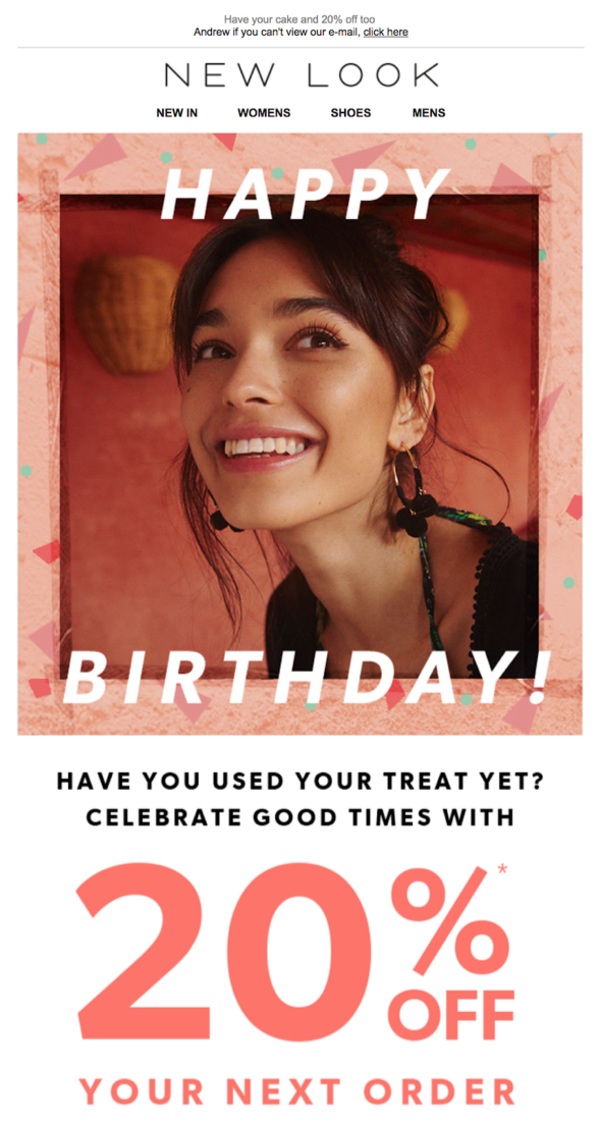
Image credit: [Curated.email]
3. Foster transparency and authenticity
Once upon a time, marketing a business was all about spin—communicating something in a way that changes how people perceive it, usually by making things seem bigger and shinier than they actually were. It’s the whole “don’t let the truth get in the way of a good story” way of doing things.
Nowadays, however, consumers are more informed. They have more access to information and are smarter and more aware as a result.
Greater access to information has led to a rise in “conscious consumption”, which The Guardian describes as “a movement of people who seek out ways to make positive decisions about what to buy and look for a solution to the negative impact consumerism is having on our world.”
As a brand, you shouldn’t want to be anything other than honest and up-front. Not only because fakeness is easier to spot, but because transparency and authenticity create loyal customers.
Research from Label Insight shows that 94 percent of people are more likely to be loyal to brands that are completely transparent and 56 percent of people would stay loyal to a brand for life if it was completely transparent.
There’s a financial benefit too: Seventy-three percent of people say they would pay more for a product that was completely transparent. And if you’re more transparent than your competitors, 40 percent of customers are happy to switch brands.
What does transparency look like for brands?
For social media management tool Buffer, transparency has been part of the company’s approach since day one. The brand openly publishes salaries, equity, pricing, fundraising, product roadmaps and more on a “Transparency Dashboard.”

Even the bad news is laid out for all to see. When Buffer was forced to lay-off 11 percent of its team, founder Joel Gascoigne documented the mistakes made in a blog post on the site.
For Chipotle Mexican Grill, transparency came as a reaction to a major e-coli breakout. With sales devastated, the company made the decision to run marketing campaigns to admit they messed up, apologize, and fix the mess they were in.
Customers appreciated the openness and traffic bounced back once restaurants reopened.
“To the extent we learned anything from those, it is that being transparent and honest with our customers works,” Chipotle CMO, Mark Crumpacker, told Fortune].
So, how do you make transparency a part of your business? There are several approaches you can take, including:
- Holding yourself and your business accountable: If you’re transparent, you’ll be able to inject that transparency into everything you do. Define your brand mission, vision, and purpose and publish it to the world. Then, hold yourself and your employees accountable to each of your values.
- Being human: If you fall below expectations, fess up, fix it and move on. Everyone makes mistakes. Customers will stick by you if you own it. KFC did this brilliantly by releasing an ad apologizing for the fact they ran out of chicken in the UK.
KFC's 'our bad' ad is brilliant. pic.twitter.com/CHFU5HDcrO
— Alex Goy (@A1GOY) February 23, 2018
- Pulling back the curtain: Let people see the inner workings of the machine. If there are changes in the company, tell customers via social media or email. Tell them simply and clearly how you use their data. Create vlogs and blog posts that document goings on. Reach your audience on a personal level and make them feel part of the brand.
If you’re authentic with customers, they’ll reward you with their loyalty.
4. Test new, time-limited offers
Loyalty comes from positive experiences with your brand, usually after having purchased your product. But for this positive experience to go ahead, sometimes customers need a nudge in the right direction.
Time-limited offers are that nudge.
Offers that say “Hurry while supplies last!” or “Act now” or “Ends Tuesday” appeal to the two main aspects of customer psychology: urgency and scarcity.
- Urgency makes the customer feel like something is so important that they must act fast.
- Scarcity creates FOMO (fear of missing out) by using low supply to create high demand. We naturally attach a higher value to things that are harder to get.
Here are a few simple ways to test time-limited offers own your products:
Set a deadline
Deadlines are great at increasing urgency because they play on the importance of time. If we don’t have long to order a product or sign up for a course, we’re more likely to make a spur of the moment decision.
Amazon does this well with a delivery countdown on its product pages.

Pick a deadline and run with it.
- Order before 3pm to get your item the next day
- Sales ends at midnight on August 31st
- The deadline for sign-ups ends on June 30th
Create limits
Limits ramp up the scarcity. Are there only a few places left on your course? Is a certain product only available for a limited run? Make it known.
Putting a limit on your product and service makes people more likely to act.
Webcredible uses this tactic on its SEO training courses.
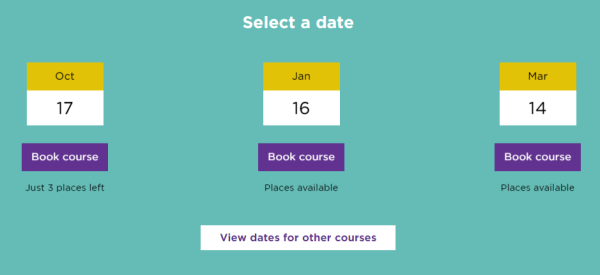
Image credit: Webcredible
Use language to promote urgency
Words like “hurry” and “now” get people to act. It’s why brands like Samsung use “Buy Now” on landing pages.

Inverawe combines urgency and scarcity by using “Hurry While Stocks Last” on its sale page.

Test different urgency words on call-to-action buttons and measure the results.
Create importance with numbers
Big numbers make things seem more important and therefore more urgent. Neil Patel uses this tactic to encourage people to sign up to his advanced SEO webinar.
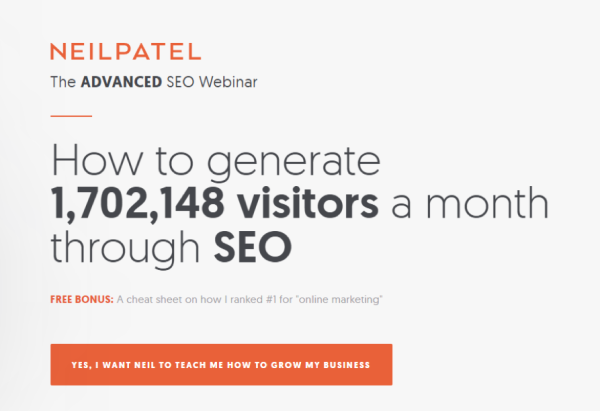
And Basecamp harnesses the power of numbers to show how popular its platform is.
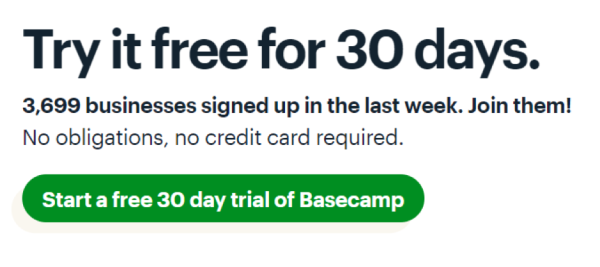
Test colors
Red is known for creating urgency. It’s why it’s used on stop signs. When Visual Website Optimizer tested three versions of a “Buy Now” button—a white button with green text, a green button with white text, and a red/dark orange button with white text—the company found that the red button converted 5 percent better than the others.
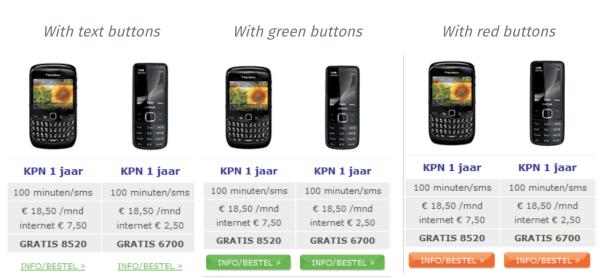
Image credit: Visual Website Optimizer
Button colors are easy to test. Experiment and see which colors work best in getting customers to act. These approaches will greatly improve the results of your lead generation efforts.
5. Spike Your Customer Experience
Customer experience (CX) is defined as:
*“The entirety of the interactions a customer has with a company and its products.” *
A customer who has a positive experience with your business is more likely to stick with you. In fact, it’s the customer experience that creates the brand advocates we talked about in the first tip.
A study by American Express found that 60 percent of customers are willing to pay more for a better experience. What’s worrying, though, is the fact that of the 80 percent of companies that believe they’re delivering a superior experience, only 8 percent of customers are in agreement.
Here’s how to ensure your customers enjoy a happy experience in each and every interaction with your company.
Understand your customers
To understand the needs and wants of a customer you need to be able to connect and empathize with them. The best way to do this is with customer personas. These are hypothetical customers based on the analysis and research of your real customers.
You can create personas by performing keyword research to see what kinds of searches are being performed by customers. For example, if keywords like “sale” or “discount” are popular, it would indicate price is a big factor.
Social media analytics such as Facebook Insights will give you an idea of** how users are interacting with your content.** You’ll also be able to pull specific data such as gender, location, and relationship status that be used alongside the data in your CRM to build an accurate picture of the customer.
Here’s an example of a persona from the Alexa blog:
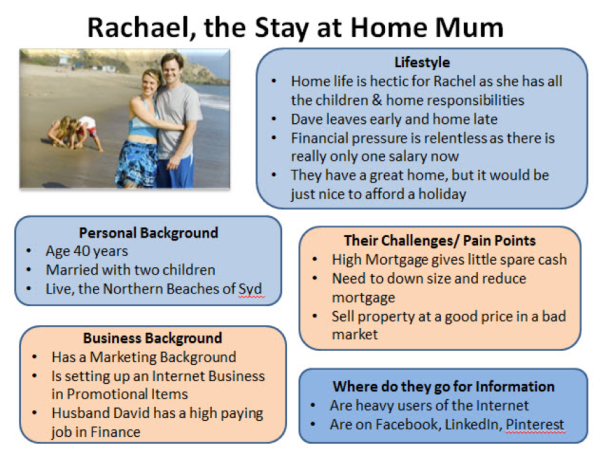
Image credit: Alexa
Personas will help bring your company closer to customers in order to create an emotional connection. Speaking of which...
Create an emotional connection
Customer loyalty is created through emotional attachment. A person will remember how you made them feel.
You create this emotional connection, not only through a great product or service, but by going out of your way to help the customer.
Little things make the biggest difference. Like when customer experience expert John DiJulius left something important behind in his room at the Ritz Carlton.
“I left The Ritz-Carlton Sarasota in such a rush for the airport that I forgot my laptop charger in my room. I planned to call when I got back into my office, but before I could, I received a next-day air package from The Ritz-Carlton Sarasota. In it was my charger, with a note saying, ‘Mr. DiJulius, I wanted to make sure we got this to you right away. I am sure you need it, and, just in case, I sent you an extra charger for your laptop.’ The note was signed by Larry K. Kinney, in Loss Prevention.'”
Go above and beyond to prove to customers that you care.
Be easy to reach
Communication is a big part of the customer experience. You’ve got to be where they are, when they are.
Do this by being easy to reach across multiple channels. Whether it’s email, social media, forums, or live chat, find out how your customers communicate and provide a consistent service so that they know they can reach you in times of need.
If it’s out of office hours, have a FAQs page or knowledge base where customers can go to find answers. It all helps show customers that you care.
Make the experience simple
If a customer wants to give you their money, it’s in your interest to make it as easy as possible for them to do so. This means providing a straightforward shopping experience that allows customers to shop how they want to shop. It’s a tactic that’s becoming more popular, with brands allowing customers to click-and-collect items or checkout as a guest.
Nordstrom is a great example of a company that puts convenience at the forefront. Via the company's website, a customer can select an item, book a changing room and have it ready to try on in person within two hours.
The service gives customers control over their time. And it’s been a huge success. **Eighty percent of those that have tried “Reserve Online & Try in Store” have continued to use the service. ** They’re loyal to it.
Measure, act and improve
As customers change you need to evolve with them by tailoring your experience to meet their demands. Monitor customer feedback and measure the results.
Feedback can come from customer satisfaction surveys, social chat, customer service interactions—anywhere your customers are talking about you. The important thing is that you document, analyze, and make the necessary changes for improvement.
Conclusion
Loyal customers are the lifeblood of your business. The emotional connection that they have to you makes them more receptive to new products, more supportive of changes and more forgiving of mistakes.
Make your business easy to love. Talk to customers on a personal level, be open and honest with them, appeal to their needs, and show them you care. Do these things on a consistent basis and you’ll have returning customers for life.
Catherine Lewis is Head of Public Relations & Communications at Web.com, providing a full range of Internet services to small businesses to help them compete and succeed online.


